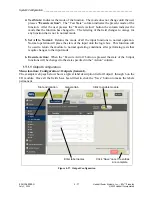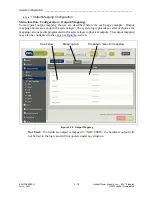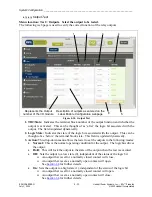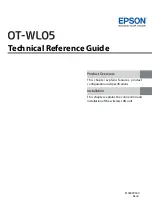
System Configuration __________________________________________________________________
RF-MCGARDPRO
Hubbell Power Systems, Inc.
–
RFL™
Products
July 1, 2022
©2022 Hubbell Incorporated
4-35
become active if the module is not responding on the control bus. If the card is returned
to the chassis in the same slot the alarm will clear automatically within one minute.
Pressing “Reset” will record the current inventory and reset the alarm.
There is a
four-minute delay before a module drops out of inventory. Cards are added to inventory
almost instantly.
Note:
An SOE entry is made if an inventory mismatch alarm occurs.
2.
System Clock:
Alarm will become active if the expected clock source is not healthy.
See
Configuration > System > Clock Tab
3.
Power Supply Alarm:
The alarm goes active when
a power supply
output voltage is
measured to be outside of the acceptable range.
Internal:
4.
Logic Bus Error:
Alarm will become active if a problem or conflict is detected on the
logic bus. Always review the logic configuration to ensure that no bits are being driven
by more than one source.
CAUTION
This is a serious alarm, contact HPS/RFL for assistance.
5.
Comm Bus Error 1 and 2:
An un-configured COMMS bus will cause the alarm to go
active. The alarmed COMMS bus needs timing source from digital comms head.
6.
System Bus Error:
Goes active when unexpected messages are detected on the control
bus. The alarm will stay active until manually cleared by pressing “Reset.”
CAUTION
This is a serious alarm, contact HPS/RFL for assistance.
4.11.2 System Alarm Configuration
Menu location: Configuration > Alarms.
The following web page is used to set system alarm levels in the HPS/RFL GARD Pro system.
The alarm configuration web page lists each module in an HPS/RFL GARD Pro system and
allows mapping of the modules alarm state to the HPS/RFL GARD Pro system alarm contacts.
On this web page the user can map any module alarm to activate the HPS/RFL GARD Pro system
-
major alarm,
-
minor alarm,
-
both major and minor alarms or
-
no alarms.
Under normal operating conditions when the alarm conditions are healthy the relays are
energized. In an alarm or alert-state the relays will be in the de-energized position.
Note
:
All relay contacts are labeled in the de-energized position.
















































